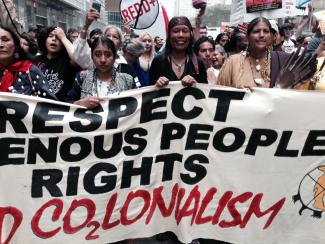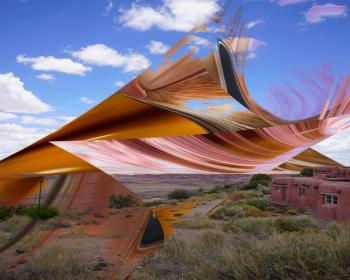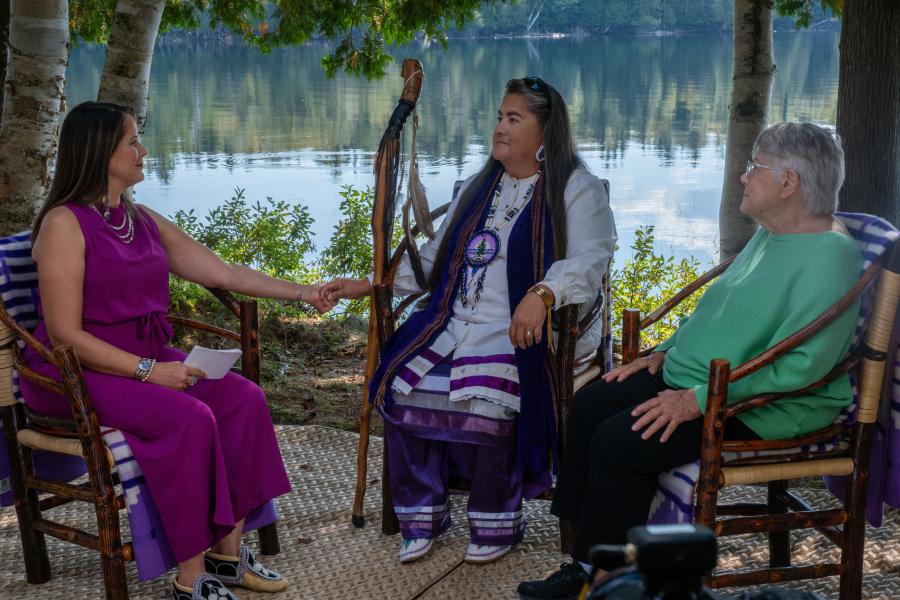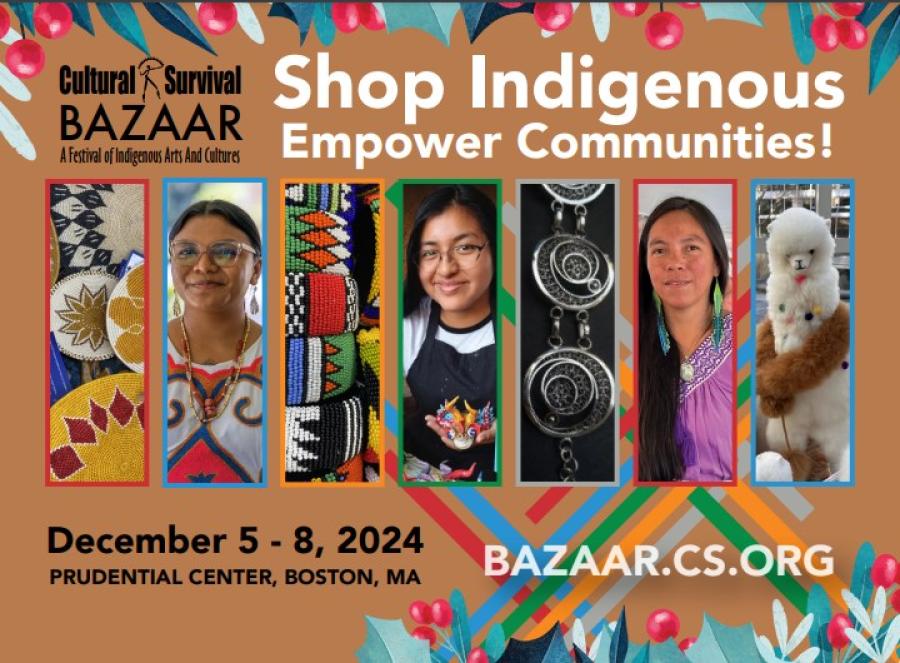
Close to 400,000 people turned out in New York City on September 21, 2014 for the People’s Climate March, the largest environmental protest in US history. With participation far exceeding expectations, the streets of Manhattan were filled with Indigenous Peoples, environmentalists, politicians, musicians, students, farmers, celebrities, nurses, labor activists, and other concerned citizens united in their demand for urgent action on climate change. Cultural Survival also attended the historic event and captured the voices of participants demanding climate justice and fulfillment of Indigenous rights.
Mililani Trask Native Hawaiian Indigenous rights lawyer and activist
The climate change march is critical, and I’m so happy that it occurs now at the very time that we are bringing Indigenous issues to the World Conference and the General Assembly. Every sector of civil society is coming here: Indigenous, non Indigenous—everyone is standing up, demanding that we have directional policy, action on climate change. I think it’s something that is terrorizing some of the private sector, especially those that continue to benefit from fossil fuels. It brings into the picture some who thought they might be able to sidestep it, like the liquid natural gas industry, which is now using things such as fracking, very dangerous to the environment.
For Hawai’i, we are one of the two most critically impacted regions. The two Indigenous regions impacted most acutely are the Arctic and the Pacific. In the Pacific we have countries like Tuvalu that are going underwater. And we have significant concern in many of the Pacific island archipelagos that things are changing in terms of marine life because of the climate. An Indigenous woman from California told me that for the first time in their history, the blue whale comes into Half Moon Bay; previously it was a place reserved for the great white sharks. In the Pacific the critical impact is that the low-lying islands are literally being flooded. And as the water comes in, even some of the high islands are finding that the intrusion of the ocean water is destroying the freshwater bays. So this could render many Pacific islands uninhabitable.
When it comes to environmental issues it’s always been dominated by liberals and the environmental organizations, some of which are US-based and some of which are globalized, just like the transnational corporations. Environmentalists tend to speak about the environment in an absence of human beings, and they tend to rely foolishly on Western science. We know today that the traditional knowledge of Indigenous Peoples relating to the Earth and resource management is critical. In many instances it’s been shown that Indigenous traditional knowledge spans periods longer than written history. So when we look at answers for things like saltwater intrusion onto islands, we need to resort to that kind of traditional knowledge. I was speaking with a woman from the Cook Islands last week about what was happening with saltwater intrusion there, and she said it was fortunate for them that the taro is their base food—they had perfected in traditional times certain taro that could survive in reef and saltwater environments. They’re going to find these taro and plant them at the shoreline because it will be the only food that will survive. That’s just a small example of how traditional knowledge can help us address some of the problems of climate change. We’ve seen, over the last 20 years especially, very strong bonding and cross cultural relationships forming. Much of it grows out of our work at the UN, because we all stand together to fight for human rights for Indigenous Peoples. But some of it arises because Indigenous women decided a long time ago that they would make these linkages with other Indigenous women. This is why I know Winona LaDuke, because she is a founding mother of the Indigenous Women’s Network of the United States. These things came about because Indigenous women saw that this need was going to be arising and they organized for it. We now have the ability to keep those bonds because we can organize by using technology, whereas before we were greatly hampered by the poverty in the movement and the far distances between our peoples. I think where we can do our best, Indigenous, non-Indigenous, and the environmentalists, is standing together with a strong strategy. We’re going to have to address the transnationals and their partnerships with militarized governments. There we need to work together.
Winona LaDuke Anishinaabe, executive director of Honor the Earth
We need climate justice. We need people to take some action, and I came out to support the many Indigenous people and others protecting our planet. We have been fighting a big pipeline. The Enbridge Company has six pipelines, and they want to put in more. Some of those pipelines are 50 years old, and they want to upgrade them and bring in tar sands and fracked oil. We’ve been fighting a pipeline in particular known as the Sandpiper, fracked oil out of North Dakota. We believe that our water is more important than their oil, and we’ve been organizing and opposing them legally, on the ground, and in our communities. We’re mounting a pretty damn good opposition. We’ve stopped a lot of projects, and there’s a bunch of projects we’ve got to stop now. We’ve got to stop extreme behavior.
A lot of people don’t want their water filled with fracking chemicals, and they’d like to know what’s in fracking liquids: 600 chemicals, protected under the Halliburton Amendment. That’s messed up. Everybody is on the front lines now because there are 40 states that are projected to face fracking. That’s a lot of this country that’s got fracking potential, and that’s what you don’t want. You’ve got a choice between water and oil. You’ve got to pick the right one. Time to pick water. It’s this epic moment. It’s time to stand together and work on this. I brought my two 14-year-old sons. I was like, “You want to see where the people are? This is where they are.” We’re all in this together.
Chief Dwayne Perry Lenape
My ancestors once controlled this very land we step upon. At this moment, we are basically in midtown Manhattan, next to the Mahicantuck, the river that flows both ways, and this is our ancestral land where we would come to hunt, to fish, and to gather in the spring. Right now we are asking the world and all of North and South America to band together and stop the fracking, stop the destruction of the water, and begin the healing of the earth. Without the air, obviously, without water, we cannot survive. We have reached a critical point in this time in our world history and we need to understand that, lay away the avarice and greed, and work together to prevent further damage to our planet.
[This morning’s sunrise ceremony] was probably one of most eclectic, powerful joinings of spiritual people from around the hemisphere that’s taken place in the last number of hundred of years, and it was all focused to lift the spirits of human beings and to begin the healing of the earth. I would like to think that my people have dreamed this, and now here it is. I’m more than pleased. I thank each and every person here, and we give thanks for their lives. I hope there becomes a reality of realpolitik, and I hope that the Aboriginal, the Native people around the world can now be looked at as who they were, stewards of the Earth, and be given the respect they need. For instance, in terms of water, not only has water become a commodity, we have relatives in South America and Africa that have been murdered for that resource by some of the very people we honor here as corporate America.
I would like to say to the Indigenous Peoples of the world that now is our time. Now is our moment and we must stand together and walk forward and take positive, peaceful action. In addition, I would like the world to know that my people, the Ramapo Munsee, are being murdered through corporate greed and governmental avarice. Not somewhere else; 30 miles from Manhattan. Not yesterday; this moment, this time. And we need all the help we can get.
We’re the Ramapo Lenape, we’re the Munsee people. We are the keepers of the Ramapo Pass, an instrumental redoubt leading into the rear of the New England colonies, which we allowed control of by the American Rebels. We showed them where the iron deposits were. Without our ancestors allowing George Washington to use the Ramapo Pass, there would not have been the same outcome to the American Revolution. [But] we have not yet to this moment been afforded the dignity of human beings. To this moment, this federal government has refused to acknowledge the very people that made this union possible. And today is the day they need to listen, both for the Earth and for the Ramapo Munsee people, the Lenape people.
Tom Goldtooth Navajo/ Dakota, executive director of the Indigenous Environmental Network (IEN)
As a network organization, we’ve been working on issues of Indigenous rights related to protection of our environment. We found out in the late ’80s and early ’90s that this federal government was disproportionately siting toxic waste facilities, including toxic waste dumping, on Indian land compared to white communities. Issues of disproportionate impact were emerging where the federal laws and the standards established did not take into consideration Indigenous Peoples’ diets. For example, in certain areas like Minnesota, because of the mercury levels in the fish and the reality of our people’s high consumption of this contaminated fish, we are the walking toxic burdens. The laws don’t take into consideration these high consumption levels of our Indigenous Peoples who are dependent, not only through our food system, but spiritually connected to fish populations. That’s when we found that there’s an issue of racism in environmental protection and how it’s developed, so that’s how we organize, not only around environmental racism, but also looking at economic injustices.
There was concern from elected tribal leaders about this trend of the federal government reaching out to tribal nations with these ideas and proposals [for nuclear and toxic waste dumping] that the nuclear waste industry and the government could use their technology and say to our tribal leaders, ‘you have the spiritual knowledge and you are one with the Earth, and with our technology we can become partners and brothers.’ That was the concept in the early ’90s. And our communities stood up against this and said, ‘This is wrong.’ But some of our tribal leaders also thought that this might be a new mechanism for economic development. We found that in Indian country there’s a lot of inaction and failure in the federal agencies in helping tribes develop environmental protection infrastructures. When we organized as the Indigenous Environmental Network, we lifted up this issue of environmental inequity in the funding mechanisms available for tribes to develop their environmental protection programs. We have something that makes our issues different than other people of color around environmental racism: we have a political and a legal relationship with this US government, so they have a fiduciary responsibility to help tribes develop mechanisms to protect our environment. It’s a treaty right of hunting and gathering and planting crops. If our soil is contaminated, if our food is contaminated, then that’s a violation of that responsibility.
We found that there’s a lot of toxic chemicals released into the environment that have disproportionate impact to our women especially, like dioxin and other toxic chemicals that persist and biomagnify in the environment. In Indian country, many of the doctors are assigned to provide health care through federal governmental programs like Indian House Service; many of them weren’t equipped to really know of the epidemiology and the health impacts. They sometimes misdiagnosed symptoms as part of diabetes, or didn’t know how serious it was when our immune system was already weakened by alcoholism and other diseases, again magnifying the impact of these chemicals in our body. As IEN, we really took that on and developed a campaign.
About that same time, this issue of these toxic chemicals became a global issue because toxic chemicals just don’t stop at the political boundaries of Canada and the United States or Russia and China. We found that these chemicals settle in colder climates that we call sinkholes. That means our Indigenous Peoples in the Arctic who have strong subsistence cultures are actually consuming high levels of these toxins in their systems, especially women. So we became very active in the international treaty initiative called POPs, persistent organic pollutants. That was one of the first times we became active in the UN mechanisms in a treaty initiative. We’ve been using that approach in other international fora, such as the UN Framework Convention on Climate Change. This is a rights issue. That’s why we’re looking at the mitigation and adaptation policies that are emerging, and we’re very critical. We have to be very critical thinkers in policies that are developed because we’ve seen the power of money and the power of the industry, especially the petroleum industry.
The stakes are pretty high here. As Indigenous Peoples we’ve been pretty consistent, whether it’s the Dakota community or Navajo Dineh people. Back home on my mom’s reservation, we’re surrounded by coal-fired power plants. We’re surrounded by the fossil fuel economy, the coal mining, the natural gas and oil. We know it’s not easy to shut down the valve. It’s a very political issue when we talk about mining, for example. Industry is really pushing the sustainable mining objective. In our analysis as IEN, there’s no such thing as sustainable mining practices. I think environmental justice is a real issue throughout the world, and we will continue to network and build a base. We’ve launched Indigenous Rising as a mechanism. Indigenous Peoples are stepping up; we’re not just going with the show. We’re looking at alternatives and strategies and tactics for how to protect our communities and protect our future generations and protect Mother Earth.
To listen to more voices from the People’s Climate March, visit: goo.gl/CTRhQL.



